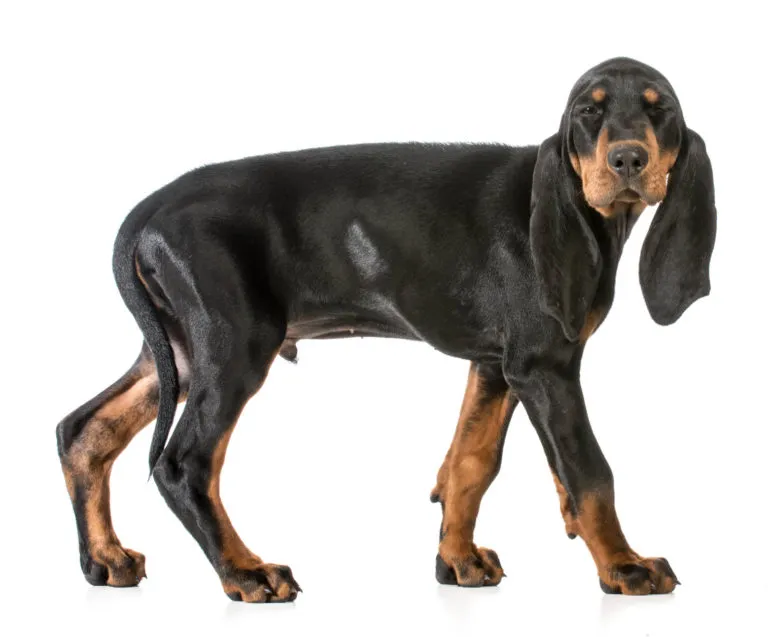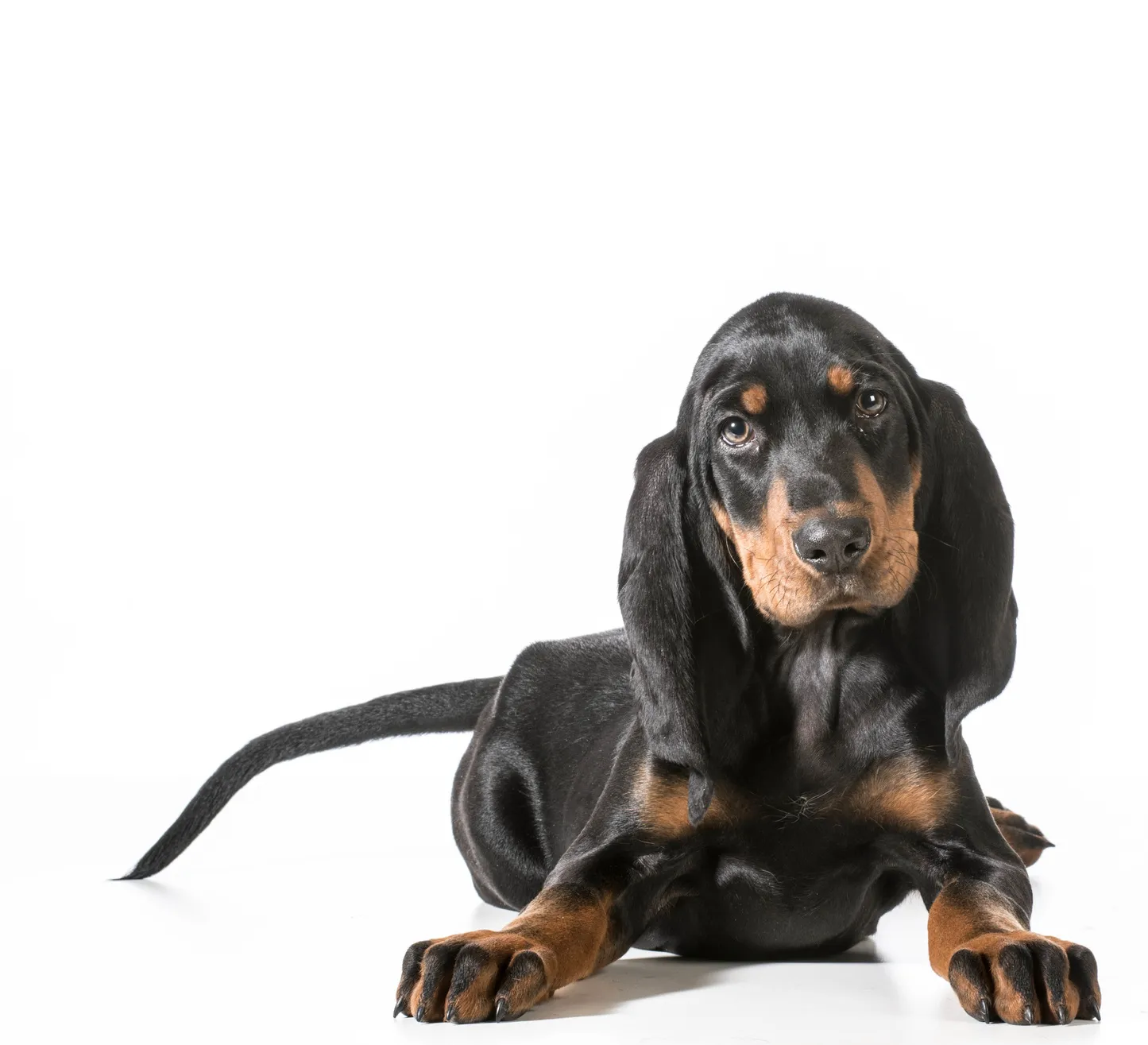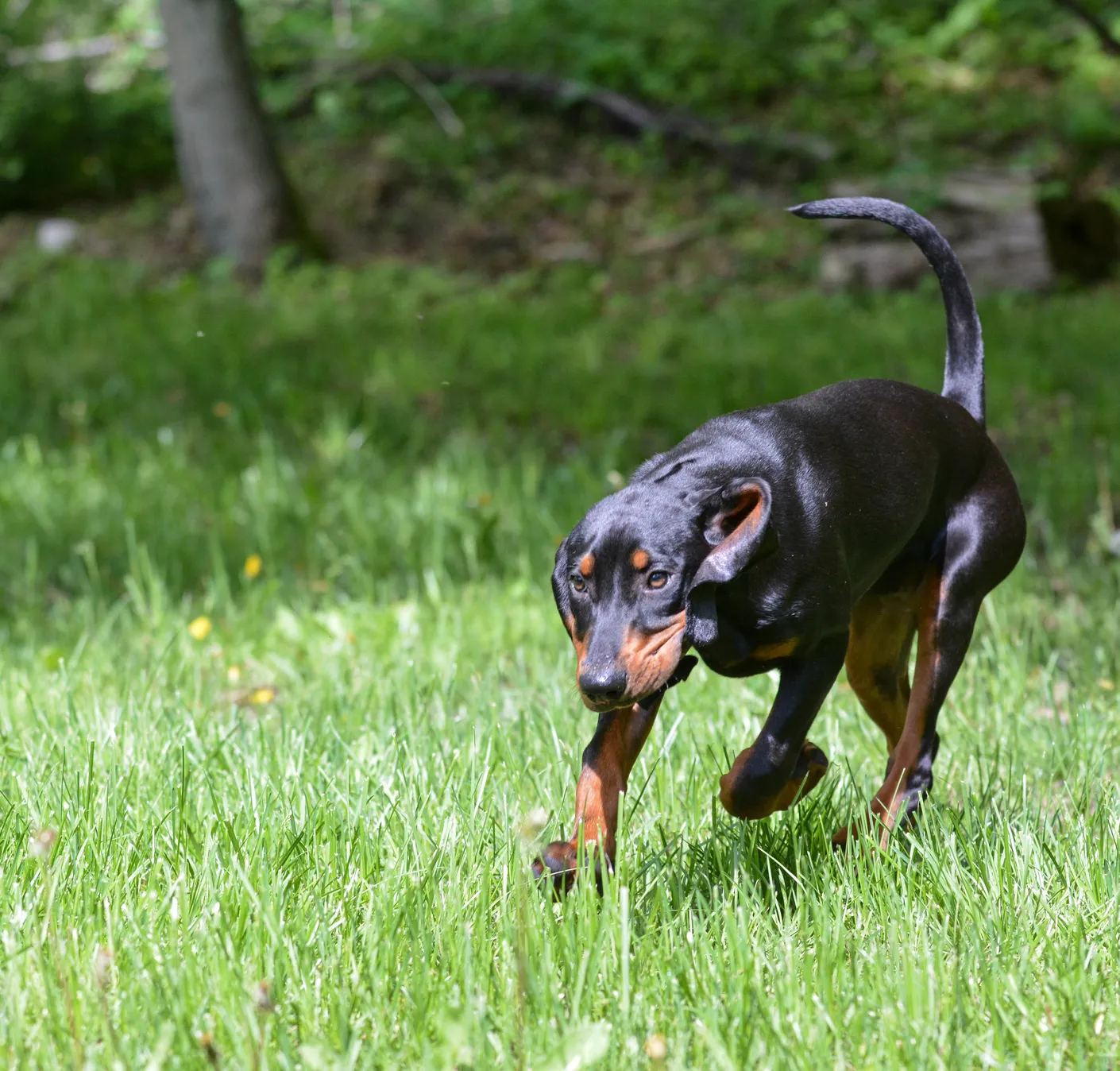Medium Size Poodle
Originating in America, the Black and Tan Coonhound finds its vocation in hunting raccoons, since it detects and pursues their trace like nobody else. The Black and Tan Coonhound strongly resembles the Bloodhound, is even-tempered and gets on well with humans and fellow dogs.

© Willee Cole / stock.adobe.com
If a Black and Tan Coonhound scents a raccoon, there’s no stopping it. It follows the trace of the raccoon unswervingly with its refined sense of smell, observes it and forces it to flee up a tree. The dog then barks at the raccoon, making a striking, horn-like cry until the hunter comes. The American Black and Tan Coonhound is highly methodical and conscientious when hunting and tracking – raccoons or opossums have no chance against these tenacious and determined pedigree dogs.
Whilst their perseverance and strong will is highly valued when it comes to hunting, it can partly prove somewhat of a hindrance with regard to rearing and training. Coonhounds can be downright stubborn and headstrong – especially if their owner doesn’t give them enough attention or delivers their commands with too much severity. However, if you give these dogs appropriate tasks, permit a healthy measure of freedom and can satisfy their urge for exercise, you will find the Black and Tan Coonhound a very even-tempered and good-natured companion that feels perfectly at ease in families with children.
In general, Coonhound are very sociable and open dogs that both like and need human company. Being alone for too long can prove unsettling or lead to destructive tendencies. They also get on fantastically with other dogs and those of the same breed – after all, they work closely with other dogs when deployed as hounds. Shy or even aggressive behaviour is absolutely alien to these contact-loving American dogs. Although they initially keep their distance when encountering new people, they are generally open to their advances. They only make suitable watchdogs to a limited extent, despite their courage and determination.
The imposing size, determined air with a powerful, expansive gait and elegant jet-black fur with vivid tan-coloured markings make the Black and Tan Coonhound a very eye-catching and impressive companion. The Coonhound can thank its “big brother”, the Bloodhound of Belgian origin, for its strong, muscular body with long, well-proportioned limbs and long lop ears. The BTC doesn’t have the typical skin folds though and is also somewhat smaller and lighter than the Bloodhound. It reaches a height of 58 to 69cm and weighs approx. 25 to 34kg.
Along with the trademark long ears that hang down low over the face, the strong gait also stands out. Although the dark-brown eyes radiate real calm and serenity at home, the Coonhound proves outdoors that it is a throughly talented and enduring athlete with immense strength and agility. The jet-black fur with intensive tan markings is short and thick, providing an excellent protective layer in all weather conditions. It fits tight to the body and elegantly emphasises its clean muscular lines.
The Black and Tan Coonhound is closely linked to the history of the US, its country of origin. In the 17th and 18th century, what was known as “coonhunting” (hunting raccoons and opossums) became a popular leisure activity in America. It therefore made sense to produce a hunting dog trained for this task in particular that could sniff out the raccoon’s trail from a long distance with its good sense of smell. The scouts Simon Kenton and the Poe brothers from the Ohio Valley, who made a name for themselves in a ferocious battle against American natives, were the first to dedicate themselves to breeding Coonhounds. Their “Old Glory Line”, formed by crossing Bloodhounds, American Foxhounds and Irish Kerry Beagles, is the first Black and Tan Coonhound breeding line.
 © © Willee Cole / stock.adobe.com
© © Willee Cole / stock.adobe.com
An outstanding hunting and tracking dog developed from the most famous systematic pedigree line of the Black and Tan Coonhound breed, which has endured for more than 130 years. However, the Merritt brothers also made a significant contribution to the development of today’s American Black and Tan breed, as well as Don Stringer’s Ten Oaks line. The American Kennel Club refused to recognise Coonhounds as an independent breed for a long time though, since they were merely considered a variety of foxhound. In 1945, the endeavours of the Black and Tan Coonhound Club were rewarded by establishing compulsory breed characteristics and the BTC was the first and only Coonhound to be accepted by the AKC. The FCI (Fédération Cynologique International), the international cynological association, followed the American Kennel Club with this assessment and accepted the Black and Tan Coonhound in the same year.
In the US, the Black and Tan Coonhound hunts raccoons to this very day, as well as deer, bears and other large game. In addition, the Americans value the breed as a sociable and sporty family dog, which captivates with its good nature as well as its excellent sense of smell. In contrast, these gifted man-trailing dogs are only rarely found in Europe. The few breeders who breed the BTC outside of the US mainly make use of dogs from the American or Canadian lines.
Anyone who wishes to buy a genuine Coonhound in Europe and doesn’t have the opportunity to directly consult breeders in the US generally needs plenty of patience for their search for a puppy to be successful. However, the waiting period can be put to good use. This doesn’t just mean making your home “dog-proof” and buying the necessary equipment. In addition, you should find out through discussions and meetings with Coonhound owners and breeders, as well as with other experienced hunting and hound dog owners, whether the Black and Tan really is the right dog breed for you. Does your expectation of life with a BTC match with the peculiarities of the breed? Do you have enough time to give your dog the required exercise and meaningful activity? Does everyone in your family agree on purchasing this pedigree dog? Give yourself time to answer these questions and rethink your decision to make the purchase if doubts emerge regarding one or more questions.
Once you’ve got a Black and Tan Coonhound home in the first place, there’s no need to fear veterinary appointments, generally speaking. Thanks to prudent breeding, this American breed is considered very robust when facing diseases. Breed-specific complaints are unknown. However, some Coonhounds do suffer from hip dysplasia (HD), which is very widespread. The risk of this can be reduced though, both with an HD-free breed family and cautious rearing and nutrition, so that the dog’s joints are not overstrained during the growth phase. During the puppy phase, excessively quick games of fetch with short, abrupt stops or frequent stair climbing should be avoided. Diet has further important significance in this context.
 © Willee Cole / stock.adobe.com
© Willee Cole / stock.adobe.com
If puppies have a diet that is too protein-rich, this can lead to premature growth. Muscle and bone formation becomes unbalanced and can later lead to skeletal disorders. Hence, make sure you choose a food tailored to your puppy’s needs. After purchasing a puppy from a breeder, it is advisable to continue to give it its usual food that it received from the breeder after the lactation period. After a few weeks, you can then switch to an adult food. The food composition should always correspond to your dog’s nutrient and calorie requirements. Young dogs should receive a low-protein food with a healthy ratio of calcium to phosphorous.
An adult Coonhound’s food should primarily consist of meat (approx. 70 to 80%). Rice and vegetables are a diverse and healthy supplement. Make sure to feed your dog at fixed times (twice per day) and not to exceed the required daily intake with too many snacks or treats. Coonhounds by nature have a tendency to become overweight, which can lead to serious health complications as a consequence. Clear away your dog’s food bowl at the end of the meal – it is not allowed to eat as it pleases at all times of day. On the other hand, fresh drinking water should always be available.
Thanks to the short fur, grooming a Black and Tan Coonhound is relatively straightforward and not very time-consuming. In order to maintain shine and structure, it is sufficient to brush the fur regularly (around twice per week). In addition, you should check and clean the lop ears and eyes in particular at regular intervals. Coonhounds sometimes have a tendency to develop inflammation under their ears and around their eyes. Appropriate care can prevent such ailments or at least reveal them at an early stage.
The Black and Tan Coonhound is a large, sporty working dog that needs lots of space, exercise and activity. People who live in a city apartment, who prefer lying on the couch to exploring the woods and who are merely fascinated by this breed’s cute lop ears would be best advised to opt for a different dog breed. If you aren’t going to hunt with the Coonhound and will instead keep it purely as a family dog, you absolutely must offer sufficient replacement activity. Dog sports and especially search work (e.g. an-trailing) are ideal for these North American dogs with an excellent sense of smell. Professional deployment with the police or customs is also possible for these tracking experts.
Only when the Black and Tan Coonhound receives an appropriate task will its even-tempered and calm nature fully come to fruition. The success of its training also depends not least on how stimulated your dog feels. Dogs that are often left alone and live as “sofa dogs” often develop undesirable habits. Constant loud howling, hunting neighbours’ cats or destroying your favourite armchair are just a few examples. These intelligent pedigree dogs won’t accept as pack leader an owner who barely has time for them, doesn’t treat them fairly or let them participate in day-to-day life. Hence, show your dog from the beginning that it can trust you at all times. Give it the required love and attention, sufficient exercise opportunities and provide meaningful activity – then training your Coonhound will be a success (even if it can’t go hunting raccoons).
Fans of the Bearded Collie agree that those who aren't familiar with this dog breed simply have to get acquainted with it. And those who have experienced how a Bearded Collie bolts across meadows with its flowing fur, how it rolls around full of energy and joy and how it attentively and observantly takes into account its owners wishes become simply addicted to this original dog breed and its unique charm.
The Goldendoodle isn't a breed, but a pairing between Golden Retrievers and Medium or Standard Poodles. Marketed as a low-maintenance dog for allergy sufferers, this hybrid is enjoying increasing popularity amongst dog lovers, similar to the Labradoodle.